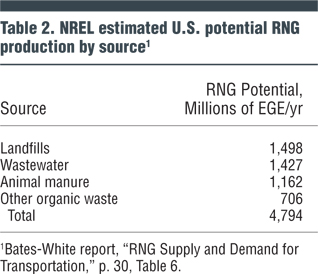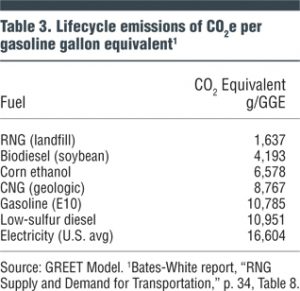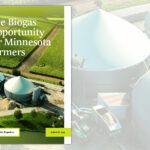New report projects sharply increased biogas demand and supply that could benefit anaerobic digester (AD) developers — amid tensions that may undercut its forecasts.
Michael H. Levin
BioCycle July 2019
In the ongoing struggle between oil refiners, “conventional” ethanol producers, cellulosic biogas generators, and other parties to shape the federal Renewable Fuels Standard (RFS), three blows recently were struck that might lead to a brighter biogas future. Two may be short-term. The third could have broader implications.
First, on May 30 the U.S. Environmental Protection Agency, which administers the RFS, finalized its so-called “E15 rule” allowing — but not requiring — gasoline containing 15 percent rather than 10 percent ethanol to be sold during summer months without special vapor pressure controls in smog areas where E15 formerly was prohibited (84 FR 26980 (June 10, 2019)). The final rule was rushed to meet the June 1 summer gas season in accord with Administration pledges to help corn growers hammered by Midwest floods and the Administration’s trade tariffs. It was opposed by environmental groups but touted by EPA and ethanol industry officials as allowing “more renewable fuel to be blended into the fuel supply” and enabling “year-round demand growth of at least 200 million [more] gallons … as only the starting point.”
However, the rule itself anticipates far more modest effects than a 5 percent increase in ethanol markets. It asserts that multiple constraints — market barriers, limited ability of current filling stations and vehicle engines to handle E15, necessary infrastructure modifications, and uncertain demand for “voluntary” E15 — likely will produce marginal industry benefits as well as marginal smog effects. Oil industry groups facing further erosion of gasoline markets predictably differed, announcing their intent to challenge the rule as “arbitrary” on the day the rule was announced.
If and when the rule encourages infrastructure investments, it also could expand markets for other renewable fuels like compressed biogas from AD facilities. Reasons include:
• The more infrastructure there is for ethanol, the more infrastructure there also may be for renewable natural gas (RNG) in terms of pipeline or tanker transport, fueling stations, and storage facilities.
• Adverse mechanical and environmental impacts related to ethanol’s corrosiveness and life cycle analyses may encourage switches to RNG.
• Cellulosic biogas from AD and landfills becoming price competitive (or better) with ethanol in more markets.
• Increased investor/user familiarity with any gasoline alternative tends to lift all boats.
Market “Reforms”
Second, the E15 rule accelerated Administration decisions on a clutch of proposed “market reforms” meant to prevent asserted “RINs market manipulation.” The White House directed EPA to pursue these reforms last October. RINs (tradeable Renewable Identification Numbers or certificates) are a potentially critical revenue stream for AD and other facilities that can produce compressed or liquid vehicle fuel.
The need to prevent profiteering “manipulation” was problematic from the start. This was because RINs demand and RINs prices already were at historic lows due to the Administration’s issuance of “economic hardship” compliance exemptions (known as “waivers”) to “small refineries” — including some owned by oil majors — at nearly quadruple those exemptions’ historic rate (see Box).
Despite the White House directive, EPA found no evidence that RINs price levels or volatility resulted from intentional hoarding or other manipulation, rather than “normal swings” characterizing a market where government announcements can have outsize effects because the government uniquely determines both supply and demand. It declined to adopt proposals that might have stifled RINs market liquidity — e.g., eliminating brokers’ ability to hold or sell RINs, capping the amount of RINs any regulated refiner could hold, or requiring RINs to be retired instantly rather than yearly. Those proposals were deferred for “further study,” apparently forever.
Instead EPA merely required narrow additional reporting where an enterprise’s RINs holdings exceed 3 percent of an applicable fuel-specific annual national Renewable Volume Obligation (RVO) and any affiliate of that enterprise holds more than 130 percent of its individual RINs obligation for the year. This action imposed no new substantive mandates. It also applied only to the ethanol segment of the renewable fuels market, leaving AD and other biofuel producers unscathed.
RNG Coalition Report
Third, just before the E15 rule was announced the Renewable Natural Gas Coalition released a credible third-party report, “Renewable Natural Gas Supply and Demand for Transportation,” prepared by Bates White Economic Consulting. Circulated to Congressional staff before its public release, the report apparently was developed in part as a response to a stream of Administration steps that threatened to undercut RINs markets and biogas development. It seems to explode historically low government estimates of cellulosic biogas supply and demand. But its findings go well beyond that.
What The Report Addresses
The report confirms that the U.S. Department of Energy’s Short-Term Energy Outlooks (STEOs) for cellulosic biogas production — from which EPA partly determines the volume of “cellulosic gas” refiners must blend each year — understate both current production capacity and potential near-term production. It indicates that natural gas vehicle demand in 2018 was about 1.1 billion ethanol gallon equivalents (EGE) — more than twice the STEO estimate. The report also concludes that biogas production grew 30 percent each year from 2015 to reach over 300 million EGE in 2018, and that natural gas vehicle demand should reach 1.8 to 2.5 billion EGE by 2025. It suggests that undeveloped sources of biogas with economic and environmental advantages over “geologic” natural gas could more than supply this demand.
Based on independent analysis plus reviews of studies by NREL and other entities, the Bates-White report further concludes that:
• Dairy and swine farms have “technical potential” to produce about 2.2 million EGE annually.
• “Incremental” biogas production (solely from landfill, agricultural waste, and other facilities with no current RNG projects) could total 4.8 million EGE.
• Emergent biogas markets beyond the transport sector could help absorb such production.
• Displacing diesel fuel at only 25 percent of currently unconverted U.S. municipal transit buses would generate 200 million EGE additional biogas demand.
• Vehicle fleets like school buses, delivery vans and medium-haul plus over-the-road trucks remain major underserved markets for biogas.
• Each 100 million EGE of renewable fuel production on average creates about 550 permanent jobs paying nearly $70,000 — a particularly big benefit when biogas facilities are sited in hard-pressed rural areas.
• Vehicles fueled with biogas are competitive with electric vehicles (EVs) in carbon dioxide equivalent (CO2-e) reductions on a life cycle basis, and can surpass EVs in areas with high fossil-fueled electricity emissions.
• AD projects have been rated negative for carbon intensity under the California Low Carbon Fuel Standard program, meaning they affirmatively subtract CO2-e from the atmosphere.
• Biogas markets are increasingly diverse. They now include industrial process heating, hydrogen production, and plastics manufacturing in addition to electricity generation, direct gas use and transport-related vehicle fuels.
• Biogas market growth is self-reinforcing due to increased familiarity and the “second in line” effect — the more demand is satisfied, the more infrastructure and investment become available, the more economies of scale come into play to reduce costs, and the more new customers and markets tend to arise.
• Predictable incentives — notably, more accurate (not understated) RVOs, a RINs market not subject to repeated regulatory shock effects, and reliable (not erratically extended) renewable energy related tax credits like those for CNG fueling stations or advanced biofuel production — are important to sustain such growth.
Several tables from the report (Tables 1, 2 and 3 in this article) summarize some of the Bates-White data.
What’s Not Addressed
“Renewable Natural Gas Supply and Demand for Transportation” may be as interesting for what it does not directly say. For example, it:
• Touches on but does not attempt to address the potentially large gap between “technically possible” and “economically feasible” biogas production.
• Tends to treat “biogas fuel” as monolithic despite disputes about the life cycle efficacies of corn-derived ethanol versus other renewable fuels.
• Does not deal with the impacts of low wholesale electricity rates or low RINs prices on future AD development. Nor does it note that “high RINs prices” operate — in fact, were meant to operate — to encourage refiners to build their own biogas facilities or help finance independent ones, not “punish” them with costs they generally can pass to consumers anyway.
In addition, the report does not mention the potentially important “renewable electricity” pathway by which biogas producers whose outputs fuel generators to power electric vehicles may generate RINs — a route (the “e-RINs pathway”) EPA endorsed years ago but has not yet activated. And it threatens to reignite past battles between potential allies by tacitly characterizing both corn ethanol and “geologic” — i.e., shale — gas as inferior to RNG.
Still, the report’s potential impacts are worth noting. If it helps drive biogas demand by encouraging EPA to increase the agency’s annual RVOs for cellulosic biofuel, that result would be more than enough.
Mike Levin, a BioCycle Contributing Editor, is managing member of the virtual law firm Michael H. Levin Law Group, PLLC (Washington DC) and a principal in NLGC, LLC and Carbon Finance Strategies LLC, which respectively focus on capital formation for renewable energy projects and the optimization/development of ground-mounted solar PV facilities. From 1979-1988 he was national Regulatory Reform Director at the U.S. EPA.















